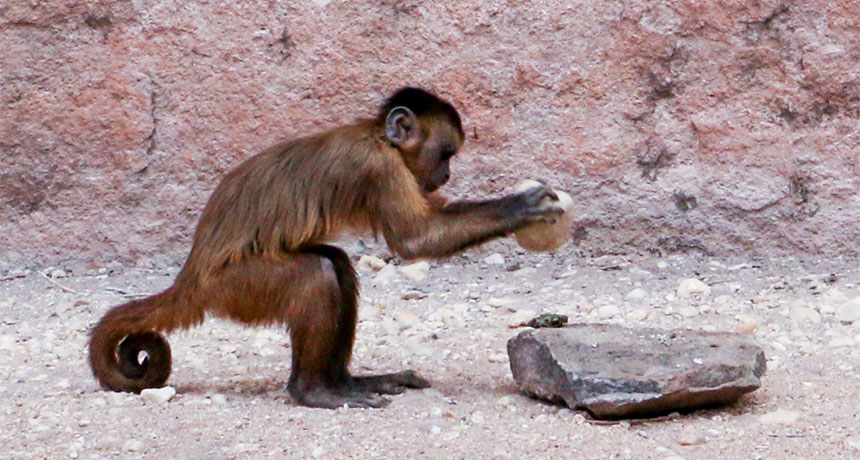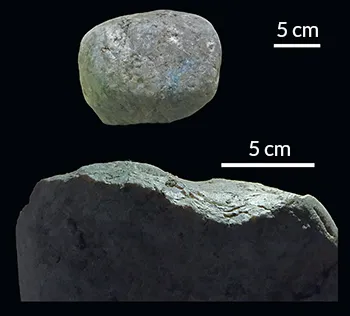Earliest evidence of monkeys’ use of stone tools found
Capuchins in Brazil used flat ‘anvils’ and round ‘hammers’ to smash nuts at least 600 years ago

NUTCRACKER A juvenile male bearded capuchin monkey uses a rock like a hammer to open a green cashew nut. Capuchins have used stone tools like these for at least 600 years.
Tiago Falótico
- More than 2 years ago
Using tools is very old monkey business.
Capuchins in northeast Brazil have wielded stones to crack open cashew nuts for 600 to 700 years, researchers report July 11 in Current Biology. Unearthed “hammers” and “anvils” are the earliest evidence of monkey tool use to date.
Today, Brazilian bearded capuchin monkeys (Sapajus libidinosus) still open cashews by placing them on the flat surfaces of anvil rocks and pounding the nuts with large stones. Unlike pebbles and other rocks, the tool stones are distinctively heavy, blemished with wear marks, greased with cashew residue and clustered under cashew trees, Michael Haslam of the University of Oxford and colleagues found.

The new findings are “incredibly important,” says archaeologist Huw Barton of the University of Leicester in England. They “will help us reassess the earliest evidence of tool use by our own ancestors.”
Capuchins are the only monkeys in South America that frequently use tools. It’s a habit they evolved independently from other inventive primates, such as humans and chimps. (The three species last shared a common ancestor some 35 million years ago.) Understanding why capuchins picked up the skill could point to situations that inspired the rise of tool use across species, says primatologist and study coauthor Tiago Falótico of the University of Sao Paulo.
Elisabetta Visalberghi, a primatologist at the Institute of Cognitive Sciences and Technologies in Rome, agrees that it’s likely that the monkeys “used tools in the past as they do now.” But she doubts that wear-and-tear scratches — which Haslam’s team used to identify buried stones as tools — were indeed produced by cracking cashews. The nuts are relatively soft; so are the stones, she says. While Haslam’s team compared markings on modern and ancient tools, they didn’t test if new marks appear on modern stones after they are used by capuchins. Visalberghi says those experiments are “fundamental to evaluate the relevance of the results.”
While this is not the first archaeological evidence of monkey tool use, it is the oldest by far. Haslam, Falótico and colleagues reported the first evidence last month in the Journal of Human Evolution: 10- to 50-year-old buried tools used by long-tailed macaques in Thailand. Before that, chimpanzees were the only primates other than humans with an ancient track record of tool use, dating back thousands of years (SN: 02/17/07, p. 99).
Compared with that of chimps, the record of capuchin tools is relatively young. But 600 to 700 years isn’t a final estimate, the researchers say. Even older monkey tools could rest in deeper soil under the cashew trees.






